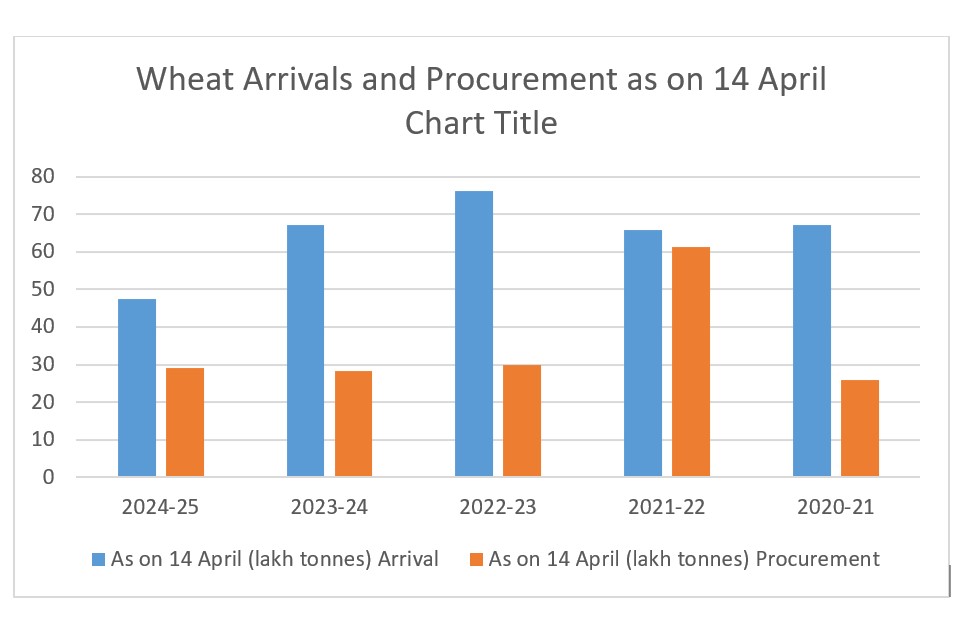Wheat Arrivals, Procurement in Mandis at Their Lowest in the Last Five Years
Every year, the arrival of wheat in mandis peaks around Baisakhi, which is generally in the middle of April. This year, Baisakhi was on April 13, and both the arrivals and procurement were the lowest in the last five years. This was due to prolonged winter and delayed harvesting in Punjab and Haryana. In all likelihood, the shortfall would be made up as harvesting peaks.
It is unlikely that farmers will retain large quantities of wheat in expectation of higher prices. Unlike mustard and soybean farmers in Madhya Pradesh and Rajasthan, which was the subject of a recent study, wheat farmers in Punjab and Haryana generally sell their entire surplus produce in peak season.

This year’s wheat procurement is critical for the government to meet its obligation under the National Food Security Act (NFSA) 2013 as the stock in the central pool on April 1 was down to 75.02 lakh tonne (lt), only 42,000 tonnes above the buffer norm of 74.60 lt.
One reason for the drawdown of wheat stock is that the government released about 100 lt of wheat under the open market sale scheme (OMSS) to check food grain inflation.
This is not as bad as in 2006 when the stock had fallen to just 20 lt against the then buffer norm of 40 lt. The government was then forced to import wheat to meet its requirement for the public distribution system.
The government needs to procure about 300 lt to comfortably meet its requirement under other welfare schemes, OMSS and NFSA, which has now been renamed as Pradhan Mantri Garib Kalyan Anna Yojana (PMGKAY).
In the last two years, the government could procure much less than its requirement of wheat for NFSA and other welfare schemes.
Also read: Wheat Stocks Fall to 16-Year Low; Private Traders Push up Buying Spree: Report
Reduced wheat allocation and criticality of Madhya Pradesh
In the pre-Covid year (2019-20), 215.60 lt of wheat was distributed under NFSA. In 2023-24, the estimated offtake of wheat is about 155.40 lt (offtake data of March 2024 is not yet available). In several wheat-eating states, instead of 5 kg of wheat per person per month, about 3 kg of wheat and 2 kg of rice were supplied in the last two years.
In the last 10 years, Madhya Pradesh has emerged as an important contributor to procurement. In 2020-21, it procured 129.42 lt which was more than Punjab’s procurement of 127.14 lt. But in 2022-23 and 2023-24, it could procure only 46 lt and 71 lt respectively. This year, MP has announced a bonus of Rs 125 per quintal. The state is critical to overall procurement. MP has the higher area under the HI1544 variety (considered just below sharbati in quality) and it is selling between Rs 2500 to Rs 3000 per quintal, which is higher than Rs 2,400 per quintal (MSP+bonus).
If procurement in Madhya Pradesh does not reach 80 lt, it may be difficult for overall procurement in India to reach 300 lt.
Like the last two years, it will again be Punjab which will provide food security to India by procuring more than 110 lt. In two previous years of low procurement also it contributed 96.5 lt and 124.14 lt respectively (graph below).

(Source: Foodgrain bulletin)
As of April 14, the arrivals in Punjab were only 38,276 tonnes. In a normal year, by Baishaki, Punjab mandis would see arrivals exceeding 5 lt. Since harvesting is delayed, it is hoped that Punjab will see much higher arrivals in the next fortnight and its total contribution to central pool stocks will again exceed 100 lt.
In the years of excessive procurement (2020-21 and 2021-22), many experts, including this writer, had been arguing for encouraging mustard instead of wheat in Punjab but the new scenario of the last two years has again highlighted the importance of Punjab as the procurement in Haryana also saw a substantial dip in 2022-23 and 2023-24.
Uttar Pradesh has been inconsistent
Uttar Pradesh has been an unreliable contributor to wheat procurement, as it contributed only 3.36 lt in 2022-23 and 2.2 lt in 2023-24. One reason for this is that the private trade avoids purchases in Punjab and Haryana due to high market fees, rural development cess and arhatiya commission.
This year, private traders, including bulk consumers like flour mills, would also be keen to replenish their stocks. So, in Madhya Pradesh, they have bought 8.32 lt out of market arrivals of 26.05 lt (32 percent of arrivals).
As per media reports, the Uttar Pradesh government has been advising private traders to stay away from procuring wheat. As a result, the procurement in Uttar Pradesh this year (1.51 lt) is much higher than about 34,000 tonnes last year. If Uttar Pradesh can procure about 50 lt, the government may be successful in procuring about 300 lt.
Looking forward
The government estimates that wheat production is 112 million tonnes. If this estimate is correct and Madhya Pradesh is able to procure 80 lt, the government will have procured sufficient quantity to meet its requirement of NFSA. Restoration of wheat allocation to pre-Covid levels should also contribute to cooling of the open market prices of wheat. This will hopefully bring wheat inflation to 5-7%.
If the open market prices remain high and wheat inflation is again in double digits, the government should reduce import duty and enable up to 2 mt of import of wheat by private trade.
Siraj Hussain is a former Union agriculture secretary.
This article went live on April eighteenth, two thousand twenty four, at twenty-nine minutes past five in the evening.The Wire is now on WhatsApp. Follow our channel for sharp analysis and opinions on the latest developments.




